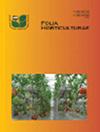亚美尼亚黑杏 Prunus × dasycarpa 栽培品种 "Shlor-Tsiran "的表型特征
IF 1.8
4区 农林科学
Q2 HORTICULTURE
引用次数: 0
摘要
Shlor-Tsiran"(字面意思为 "李子-杏")是一种古老的黑杏栽培品种,在亚美尼亚有传统栽培。在分类学上,它属于 Prunus × dasycarpa Ehrh.,是杏和樱桃李(P. armeniaca L. × P. cerasifera Ehrh.)的自发杂交种。目前,"Shlor-Tsiran "在亚美尼亚非常罕见,仅在阿拉拉特山谷的老家果园中以单株出现。与其他栽培杏相比,"Shlor-Tsiran "具有抗霜冻和抗病性强、花期和果期晚等特点,对开发果实延迟成熟和抗霜冻能力更强的杏栽培品种具有重要意义。本研究旨在对品种 "Shlor-Tsiran "进行表型,其中考虑到了无性和生殖器官、生长和发育的 67 个定量和定性特征。对变种 "Shlor-Tsiran "进行了形态学描述,并与其亲本 "P. armeniaca "和 "P. cerasifera "进行了比较。提供了有关花粉粒的繁殖力和存活率、果实的生化和营养特性以及树木产量的数据。所获得的数据将有助于更广泛地利用和保护黑杏变种 "Shlor-Tsiran "基因库,该基因库也可用于育种目的。文章配有表格和原始照片。本文章由计算机程序翻译,如有差异,请以英文原文为准。
Phenotypic characteristics of black apricot Prunus × dasycarpa cultivar ‘Shlor-Tsiran’ in Armenia
‘Shlor-Tsiran’ (literally called ‘Plum-Apricot’) is an old black apricot cultivar, which is traditionally cultivated in Armenia. Taxonomically, it belongs to Prunus × dasycarpa Ehrh., which is a spontaneous hybrid of apricot and cherry plum (P. armeniaca L. × P. cerasifera Ehrh.). Currently, ‘Shlor-Tsiran’ is considered to be very rare in Armenia and it occurs as single trees in old home orchards of the Ararat Valley. It is characterised by high frost and disease resistance, late flowering and fruiting compared with other cultivated apricots, and is of interest for the development of apricot cultivars displaying delayed fruit ripening and enhanced frost resistance. This study aims to phenotype the cv. ‘Shlor-Tsiran’ taking into consideration 67 quantitative and qualitative characteristics of vegetative and generative organs, growth and development. Morphological description of the cv. ‘Shlor-Tsiran’, comparing with its parent species, P. armeniaca and P. cerasifera , was performed. Data on fertility and viability of pollen grains, biochemical and nutritional properties of fruits and tree productivity are provided. The data obtained should contribute to a wider use and conservation of the black apricot cv. ‘Shlor-Tsiran’ gene pool, which can be used for breeding purposes as well. The article is illustrated with tables and original photographs.
求助全文
通过发布文献求助,成功后即可免费获取论文全文。
去求助
来源期刊

Folia Horticulturae
Agricultural and Biological Sciences-Horticulture
CiteScore
3.40
自引率
0.00%
发文量
13
审稿时长
16 weeks
期刊介绍:
Folia Horticulturae is an international, scientific journal published in English. It covers a broad research spectrum of aspects related to horticultural science that are of interest to a wide scientific community and have an impact on progress in both basic and applied research carried out with the use of horticultural crops and their products. The journal’s aim is to disseminate recent findings and serve as a forum for presenting views as well as for discussing important problems and prospects of modern horticulture, particularly in relation to sustainable production of high yield and quality of horticultural products, including their impact on human health.
 求助内容:
求助内容: 应助结果提醒方式:
应助结果提醒方式:


